The poultry husbandry landscape in the United States is rapidly evolving in response to public concern related to animal welfare. As the production systems become complex and the flock sizes increase, conventional welfare assessment methods can be inadequate. Technology can help us in that regard by reliably measuring behavioral and physiological indicators of welfare. In the recent years we have experienced a tremendous growth in the use of environmental and on-body sensors to monitor health and behavior of humans and pet animals. Early reports indicate that these technologies can also be useful in acquiring information on livestock and poultry welfare and health. From feeding to breeding and from compliance to flock management, technology will continue to drive all aspects of poultry production.
The use of sensing tools to continuously monitor poultry is premised on the findings that dynamic changes in bird behavior and physiology could provide clues to their welfare status. A variety of environmental, locomotion, vision, acoustic, and health related technologies are being considered in poultry production. These sensors can reliably collect behavior and physiological information and can act as farmer’s eyes and ears when human resources and accesses are limited. In this review, we will look at wearable and implantable sensors that are bringing paradigm shifts in the way poultry welfare is monitored.
What are wearable and implantable sensors?
Wearable and implantable sensors are often biosensors that can be applied to animals either noninvasively or with minimal tissue invasion. Ideally, these sensors have small component size, extended power, and robust connectivity. There are various types of wearable and implantable sensors such as accelerometers, radio-frequency identification (RFID) system, temperature capsules, microphones, heart and respiration rate sensors that have been used in chickens to monitor physiology and behavior. These sensors have been used primarily in research settings. However, technological advances have rapidly reduced sensor size and increased power and connectivity in recent years, holding great potential to be widely used in commercial production systems.
Commonly used wearable and implantable sensors in poultry
Radio-Frequency Identification (RFID)
RFID systems consists transponders (RFID tags with unique identifiers), antennae, and a receiver with a decoder to interpret the data. Often passive RFID tags with unlimited lifespan are used in agriculture. RFID has been successfully used previously for monitoring feeding/drinking behavior, environmental preferences including range use in laying hens. RFID-based tracking systems have also been used to analyze spatiotemporal distribution of hens in cage-free systems. The RFID chips are often encapsulated into a plastic or a metal ring that are attached onto the birds as leg bands. In an experimental set up recently used to monitor laying hen behavior, successful detection rates ranged between 85.8 ± 8.0% and 91.0 ± 2.6% (mean ± std dev.). With further improvement in detection range and accuracy, time-series data on resource-use patterns of chickens can be used in optimizing the housing design, understanding the social dynamics within the flock, and detecting critical control points for stressful events in the production environment.
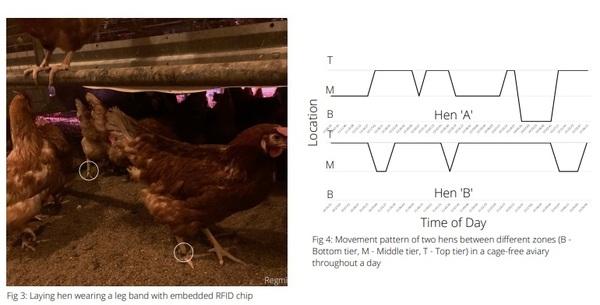
Accelerometers
Accelerometers provide the direction and magnitude of acceleration of an animal. Often, triaxial accelerometers are used in poultry to measure dynamic body acceleration in X-, Y-, and Z-axes simultaneously. Some units also incorporate an altimeter to specifically measure jumps or movements in a vertical direction. The sensitivity of an accelerometer is defined by the frequency of measurement and the threshold acceleration employed. In poultry research, acceleration as low as 0.1 G has been measured at a frequency of 100 to 1000 Hz. The wireless accelerometers can be attached to a bird using wearable structure such as a vest or a jacket. It can also be implanted under the skin if longer-term data collection is desired. Accelerometers have been used to monitor activity level in broilers and layers, gait analysis in turkeys and broilers, behavior monitoring during ectoparasite infestation in laying hens and to quantify different behaviors. Once the raw data from the accelerometer are manually/visually tagged for specific behaviors, machine learning algorithms can be trained and developed for automated behavioral analysis.
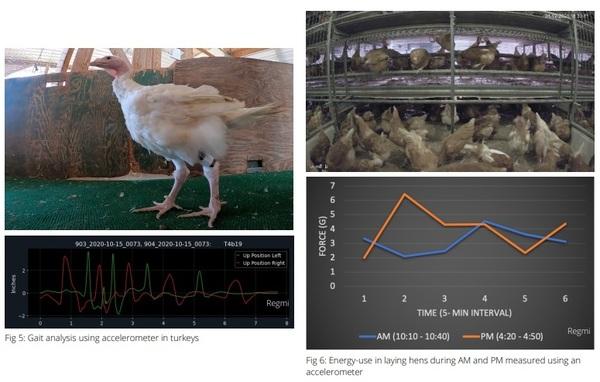
Physiological Sensors
These are often implantable micro-sensors that uses electric, magnetic or photonic signals to measure vital signals such as heart rate, respiration rate, and body temperature. Parameters mentioned above are crucial in understanding the underlying mechanisms of stress, disease, and welfare. Heart rate and core body temperatures can predict feeding, drinking, thermal stress, and even affective states of the bird. Newer products are available commercially that enable real-time monitoring of above mentioned physiological parameters.
Summary
Wearable and implantable sensors enable fine-grained monitoring of poultry behavior and physiology
At present, implanting sensors in large number of birds in commercial settings is not feasible because of higher cost and technological limitations
With advances in Internet-of-things (animals), fusion of data and data analytics from multiple sensors is possible for comprehensive assessment of poultry welfare
The sensors, however, can be employed in a subset of the population to increase the capability of the image/video based sensors that are currently used
Implantable sensors, such as the heart rate monitors, can also provide an insight into the emotional state of the bird

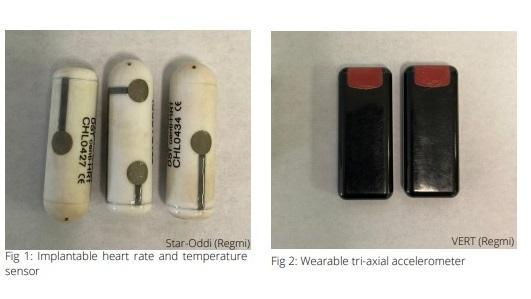


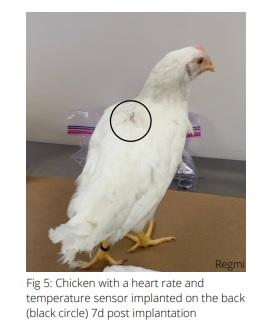
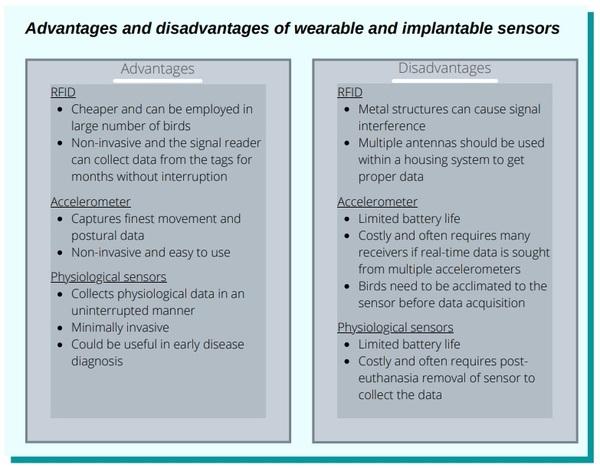
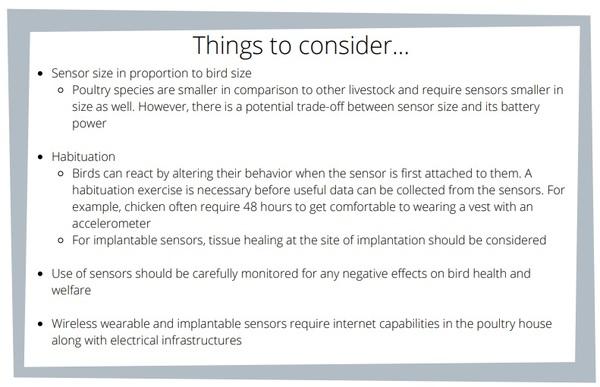














.jpg&w=3840&q=75)